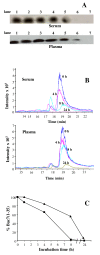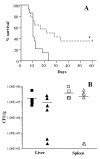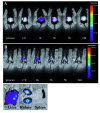The proline-rich peptide Bac7(1-35) reduces mortality from Salmonella typhimurium in a mouse model of infection
- PMID: 20573188
- PMCID: PMC2896951
- DOI: 10.1186/1471-2180-10-178
The proline-rich peptide Bac7(1-35) reduces mortality from Salmonella typhimurium in a mouse model of infection
Abstract
Background: Bac7 is a proline-rich peptide with a potent in vitro antimicrobial activity against Gram-negative bacteria. Here we investigated its activity in biological fluids and in vivo using a mouse model of S. typhimurium infection.
Results: The efficacy of the active 1-35 fragment of Bac7 was assayed in serum and plasma, and its stability in biological fluids analyzed by Western blot and mass spectrometry. The ability of the peptide to protect mice against Salmonella was assayed in a typhoid fever model of infection by determination of survival rates and bacterial load in liver and spleen of infected animals. In addition, the peptide's biodistribution was evaluated by using time-domain optical imaging. Bac7(1-35) retained a substantial in vivo activity showing a very low toxicity. The peptide increased significantly the number of survivors and the mean survival times of treated mice reducing the bacterial load in their organs despite its rapid clearance.
Conclusions: Our results provide a first indication for a potential development of Bac7-based drugs in the treatment of salmonellosis and, eventually, other Gram-negative infections. The in vivo activity for this peptide might be substantially enhanced by decreasing its excretion rate or modifying the treatment schedule.
Figures




Similar articles
-
PEGylation of the peptide Bac7(1-35) reduces renal clearance while retaining antibacterial activity and bacterial cell penetration capacity.Eur J Med Chem. 2015 May 5;95:210-9. doi: 10.1016/j.ejmech.2015.03.028. Epub 2015 Mar 19. Eur J Med Chem. 2015. PMID: 25817771
-
The antimicrobial peptide cathelicidin-BF could be a potential therapeutic for Salmonella typhimurium infection.Microbiol Res. 2015 Feb;171:45-51. doi: 10.1016/j.micres.2014.12.009. Epub 2015 Jan 3. Microbiol Res. 2015. PMID: 25644952
-
The Mechanism of Killing by the Proline-Rich Peptide Bac7(1-35) against Clinical Strains of Pseudomonas aeruginosa Differs from That against Other Gram-Negative Bacteria.Antimicrob Agents Chemother. 2017 Mar 24;61(4):e01660-16. doi: 10.1128/AAC.01660-16. Print 2017 Apr. Antimicrob Agents Chemother. 2017. PMID: 28137800 Free PMC article.
-
Dual mode of action of Bac7, a proline-rich antibacterial peptide.Biochim Biophys Acta. 2006 Nov;1760(11):1732-40. doi: 10.1016/j.bbagen.2006.09.006. Epub 2006 Sep 19. Biochim Biophys Acta. 2006. PMID: 17059867
-
Dynamics of growth and dissemination of Salmonella in vivo.Cell Microbiol. 2010 Oct;12(10):1389-97. doi: 10.1111/j.1462-5822.2010.01511.x. Cell Microbiol. 2010. PMID: 20731667 Review.
Cited by
-
In vivo Efficacy and Pharmacokinetics of Optimized Apidaecin Analogs.Front Chem. 2017 Mar 20;5:15. doi: 10.3389/fchem.2017.00015. eCollection 2017. Front Chem. 2017. PMID: 28373972 Free PMC article.
-
Antimicrobial Peptide JH-3 Effectively Kills Salmonella enterica Serovar Typhimurium Strain CVCC541 and Reduces Its Pathogenicity in Mice.Probiotics Antimicrob Proteins. 2019 Dec;11(4):1379-1390. doi: 10.1007/s12602-019-09533-w. Probiotics Antimicrob Proteins. 2019. PMID: 31001786
-
Substitution of Proline Residues by 4-Fluoro-l-Proline Affects the Mechanism of the Proline-Rich Antimicrobial Peptide Api137.Antibiotics (Basel). 2025 May 31;14(6):566. doi: 10.3390/antibiotics14060566. Antibiotics (Basel). 2025. PMID: 40558156 Free PMC article.
-
Antibacterial Peptide BSN-37 Kills Extra- and Intra-Cellular Salmonella enterica Serovar Typhimurium by a Nonlytic Mode of Action.Front Microbiol. 2020 Feb 7;11:174. doi: 10.3389/fmicb.2020.00174. eCollection 2020. Front Microbiol. 2020. PMID: 32117178 Free PMC article.
-
Inhibition of translation termination by the antimicrobial peptide Drosocin.Nat Chem Biol. 2023 Sep;19(9):1082-1090. doi: 10.1038/s41589-023-01300-x. Epub 2023 Mar 30. Nat Chem Biol. 2023. PMID: 36997647 Free PMC article.
References
-
- Zanetti M. The role of cathelicidins in the innate host defenses of mammals. Curr Issues Mol Biol. 2005;7(2):179–196. - PubMed
Publication types
MeSH terms
Substances
LinkOut - more resources
Full Text Sources
Medical

